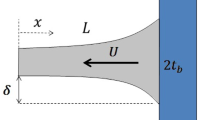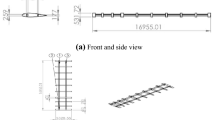The results of modal analysis of the turbine blade were presented. The turbine blade during the operation of the engine is subjected to complex thermomechanical loads induced by centrifugal forces of the rotating blade and a nonuniform thermal field. These loads have a great influence on the natural frequencies of the blade. In the first section of the study, modal analysis of the blade was performed using the vibration system. As a result, the resonant frequencies of the real blade were obtained. In order to check the effect of the rotational engine speed and the thermal field on the natural frequencies of the blade, the finite element method was employed. At the first stage of computations static analysis was conducted for the blade subjected to mechanical and thermal loads. Then modal analysis was used to isolate the natural frequencies and vibration modes of the blade. In modal analysis the stress state from the first stage was considered as preliminary conditions. Several results of numerical calculations and experimental analysis were compared to detect the relative error of natural frequency estimates.






Similar content being viewed by others
References
W. Maktouf and K. Sai, “An investigation of premature fatigue failures of gas turbine blade,” Eng. Fail. Anal., 47, 89–101 (2015).
M. Park, Y. H. Hwang, Y. S. Choi, and T. G. Kim, “Analysis of a J69-T-25 engine turbine blade fracture,” Eng. Fail. Anal., 9, 593–601 (2002).
K. S. Song, S. G Kim, D. Jung, and Y. H. Hwang, “Analysis of the fracture of a turbine blade on a turbojet engine,” Eng. Fail. Anal., 14, 877–883 (2007).
L. Witek, “Failure analysis of turbine disc of an aero engine,” Eng. Fail. Anal., 13, 9–17 (2006).
S. K. Chan and I. S Tuba, “A finite element method for contact problems of solid bodies – Part II: Applications to turbine blade fastenings,” Int. J. Mech. Sci., 13, 627–639 (1971).
L. Witek, “Fatigue investigations of the compressor blades with mechanical defects,” Key Eng. Mater., 598, 269–274 (2014).
L. Witek, “Simulation of crack growth in the compressor blade subjected to resonant vibration using hybrid method,” Eng. Fail. Anal., 49, 57–66 (2015).
Akash Shukla and S. P. Harsha, “An experimental and FEM modal analysis of cracked and normal steam turbine blade,” Materials Today: Proceedings, 2, 2056– 2063 (2015).
P. Papanikos, S. A. Meguid, and Z. Stjepanovic, “Three-dimensional nonlinear finite element analysis of dovetail joints in aeroengine discs,” Finite Elem. Anal. Design, 29, 173–186 (1998).
T. Gwo-Chung, “Rotating vibration behavior of the turbine blades with different groups of blades,” J. Sound Vibr., 271, 547–575 (2004).
E. Poursaeidi and B. Hosein, “Fatigue crack growth simulation in a first stage of compressor blade,” Eng. Fail. Anal., 45, 314–325 (2014).
L. Witek, “Crack growth simulation in the compressor blade subjected to vibration using boundary element method,” Key Eng. Mater., 598, 261–268 (2014).
A. Poznanska, M. Sniezek, and M. Wierzbinska, “Pitting corrosion – main factor generating fracture of the compressor of aeroengine blades under operation,” in: Proc. of IX Conference – Turbomachinery [in Polish], Rzeszow (2003).
L. Witek, “Failure analysis of the wing-fuselage connector of an agricultural aircraft,” Eng. Fail. Anal., 13, 572–581 (2006).
S. I. Bogomolov, S. S. Lutsenko, and S. A. Nazarenko, “Application of a superparametric finite shell element to the calculation of turbine blade vibrations,” Strength Mater., 14, No. 6, 796–799 (1982).
X. S. Yao and C. L. Zheng, “Shaking-swing coupled vibration analysis of a laminar composite rotating blade by the finite element method,” Strength Mater., 47, No. 1, 68–73 (2015).
V. T. Troshchenko, V. S. Kostenko, A. P. Voloshchenko, et al., “Automatic system of programmed control of parameters of vibration and thermal tests of gas turbine engine blades (ASPC VTT),” Strength Mater., 22, No. 1, 128–132 (1990).
R. P. Pridorozhnyi, A. V. Sheremet’ev, and A. P. Zinkovskii, “On the rational choice of the azimuthal crystallographic orientation of single-crystal cooled rotor blades in aircraft gas turbine engines,” Strength Mater., 47, No. 3, 415–421 (2015).
MSC-PATRAN 2009 Users Manual, MSC Corporation, Los Angeles (2009).
ABAQUS ver. 6.9 Users Manual, Abaqus Inc. (2009).
P. B. Mikhailov-Mikheev, Handbook on Metallic Materials for the Construction of Turbines and Engines [in Russian], Mashgiz, Leningrad (1961).
Acknowledgments
The research received funding from the People Programme (Marie Curie International Research Staff Exchange) of the European Union’s Seventh Framework Programme FP7/2007-2013/under REA Grant PIRSES-GA-2013-610547.
Author information
Authors and Affiliations
Corresponding author
Additional information
Translated from Problemy Prochnosti, No. 4, pp. 6 – 13, July – August, 2016.
Rights and permissions
About this article
Cite this article
Witek, L., Stachowicz, F. Modal Analysis of the Turbine Blade at Complex Thermomechanical Loads. Strength Mater 48, 474–480 (2016). https://doi.org/10.1007/s11223-016-9788-6
Received:
Published:
Issue Date:
DOI: https://doi.org/10.1007/s11223-016-9788-6




